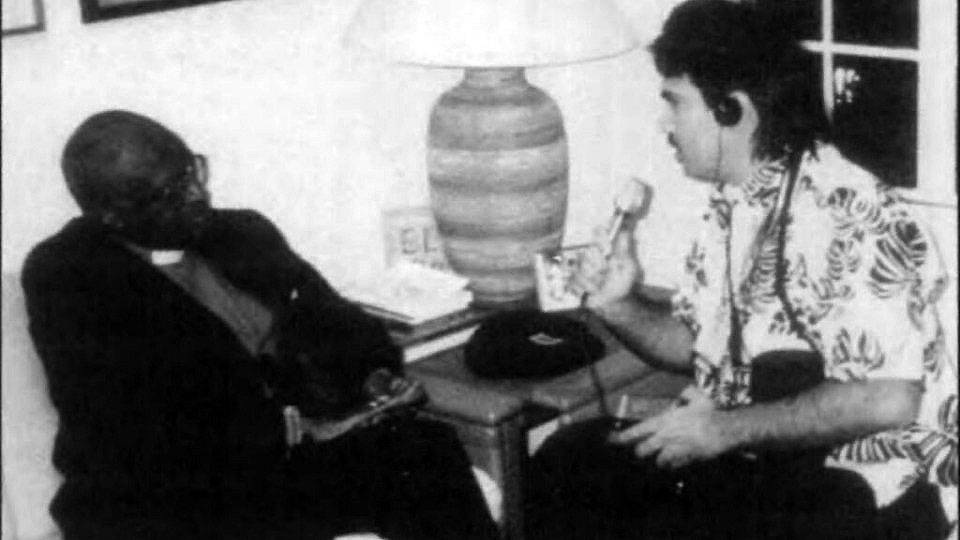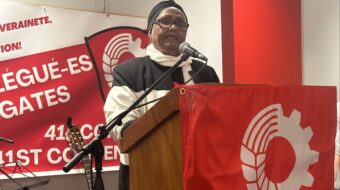
There are two top things about my profession. For me personally, a great benefit is being able to cover in person and even have access to great newsmakers whom I’d probably never have the opportunity to meet and even talk to if I weren’t a journalist. This ranges from seeing beauties such as Jennifer Lopez, Kerry Washington, and Rosario Dawson in the flesh, reporting on Nobel Laureates the Dalai Lama and Maria Ressa, and interviewing geniuses like directors Oliver Stone and Alex Gibney. At the top of this list of notables whom I’ve had the privilege, luck, and honor to encounter is Archbishop Desmond Tutu, who died Dec. 26, 2021, prompting his homeland of South Africa to observe seven days of mourning.
The following took place more than a quarter of a century ago, before widespread use of the internet, and my memory may be a bit faulty regarding some details. Be that as it may, to the best of my recollection, after the worst excesses of apartheid had been defeated and Nelson Mandela had been elected South Africa’s president, Tutu flew to Hawaii circa 1995. In downtown Honolulu, the Anglican Archbishop made a speech at St. Andrew’s Episcopal Cathedral, which was commissioned in the 19th century by a Hawaiian monarch before a white settler- and U.S.-backed coup overthrew the independent Polynesian kingdom.
Prior to his talk, the anti-apartheid leader agreed to do an interview with me, I believe for the Australian Broadcasting Corp. and/or its overseas service, Radio Australia. RA is a main source of news for and about the Pacific Islands, and I had been reporting as a stringer for this broadcast outlet since the assassination of the President of the Republic of Palau in 1985, where I’d lived at the time. My interview with the much-in-demand, extremely busy Archbishop took place in a room that was part of the large cathedral complex, where a number of aides were sitting with him. None interfered with the Q&A, although it’s possible one staffer may have informed us my allotted time was up.
Upon entering this private place, my initial impression was one of surprise, because living in Hawaii I had known of Tutu only from press reportage, wherein photos and television footage he rather heroically stood up against South Africa’s armed forces, courageously confronting the iron heel of the apartheid state. Much to my amazement, this bold figure who had such a commanding presence in the news was actually quite diminutive in physical size. This only added to my esteem for and awe of the Nobel Peace Prize winner, who was simply clad in a purplish shirt with a clerical collar and suit jacket. How many of us—including myself—would have the bravery to go toe-to-toe with a well-armed, vicious foe who towered over us?
After setting up and turning my tape recorder on, accompanied by my partner, who was in her mid-twenties and very dark-skinned, I (a Caucasian, or as the Hawaiians say, a “haole”) asked the Archbishop how—coming from a land where segregation had been so rigidly, ruthlessly enforced as law—it felt to be in the Hawaiian Islands, where what my Polynesian daughter calls “multi-culti” dating and mating were so widespread. If I thought I’d throw the African who’d grown up with the norm of racial apartness for a loop, I was totally wrong. Without missing a beat, the proponent of the multiracial ideal of the “Rainbow Nation” replied that it felt “very natural and normal.”
I asked the leader of South Africa’s social justice and equal rights movement about the cause of Hawaiian Sovereignty for Indigenous land, water, cultural, and political rights. Tutu expressed support for and solidarity with Hawaii’s Native people, who had been dispossessed and oppressed by white minority rule.
My next question, I assumed, would present an ethical conundrum for Tutu. What did the anti-apartheid leader think of the race-based laws that discriminated against people of Indian ancestry in Fiji? In 1987, Colonel Sitiveni Rabuka led two coups against a newly installed Indo-Fijian government that favored the Nuclear Free Pacific movement. The coups led to a constitution that enshrined the domination of the Indigenous Melanesians (Black Pacific Islanders) over residents whose forebears had migrated, mainly to cut sugarcane, when Fiji was a British colony.
Once again, Tutu gave me an eyebrow-raising answer filled with moral clarity. Apartheid and racism were always wrong, even if these discriminatory laws were imposed by Blacks over other people, Tutu insisted. This was big news for Radio Australia’s listeners throughout Oceania, including Fiji, where Rabuka still served as prime minister and racially biased rules still ran roughshod over the roughly 50% of the island nation’s population who were of Indian heritage.
After my interview with Archbishop Tutu, I was more impressed with him than ever. Above all, he showed himself to be an ethically consistent individual of unshakable principles he wouldn’t deviate from, even if people the same color as he were the perpetrators of wrongs. Following our tête-à-tête, I packed up my tape recorder and microphone, and my partner and I entered St. Andrew’s to listen to the South African speak. The capacious cathedral’s pews were packed, full of appreciative, supportive residents of America’s most integrated state. As he delivered a rabble-rousing address from the pulpit, Tutu was received and embraced enthusiastically by hundreds of parishioners and visitors.
And they also heartily laughed out loud. Another unexpected thing Tutu revealed was his wicked wit. I can still remember a rather hilarious joke he told in the cathedral that had everyone roaring with laughter. I can’t do it justice, with the Archbishop’s panache and his lyrical accent, but here’s the gist of it: Then in his 60s, Tutu anticipated his death, which as it turned out was at the ripe old age of 90. Upon dying, South African white supremacists would try sending him to Hell to pay for his “sin” of resisting apartheid. But the Devil wouldn’t admit Tutu into Hell. When the racists asked why not, Satan responds: “Because he’ll organize all of the political prisoners down here!”

Jean-Paul Sartre may have quipped that “Hell is other people,” but Desmond Tutu gave us the hope and a glimpse into the possibility that Heaven, too, could be other people. Beholding him was like encountering a human lightbulb. After meeting him, I almost felt sorry for those defenders of apartheid he’d faced down; while those thugs were armed only with machine guns, tanks, teargas, and the like, Tutu was fortified with truth, righteousness, and an unmovable moral conviction. The murderous South African racists, as history has shown, were completely outgunned.
The day after the world-historical leader electrified an Oahu audience of hundreds, there was scant, if any mention at all of Bishop Tutu’s speech at St. Andrew’s (where he’d return to lecture in August 2012) in Hawaii’s newspapers. The dailies prominently featured another Black man, boxer Mike Tyson, who was very far from Hawaii. The moral of the story is: If you’re Black and beautiful, a noble Nobel Peace Prize winner, you don’t rate MSM coverage. But if you’re Black and brutal, the so-called “Baddest Man on the Planet,” you qualify as front-page material. (One of the owners of a Honolulu paper was directly descended from a rabid white settler who participated in the overthrow of Hawaii’s last monarch in 1893.)
The other great thing about being a journalist is that you have an opportunity to give a voice to the voiceless, to provide a public platform to those outside the “mainstream” whom MSM might otherwise not cover or allow their side of the story to be told. A photo of me interviewing “Arch” appears in the 1996 book Autobiography of Protest in Hawaii, which I was interviewed for as the only freelance journalist in the Aloha State who focused on covering Hawaiian and other Pacific Islander subjects. (See here.)
Meeting Archbishop Tutu fulfilled both of my favorite things about being a journalist: My profession not only enabled me to meet a world-famous champion of human rights but to empower him to deliver his message. Desmond Tutu may have been slight in height but he was a colossus in stature. Rest In Power.









